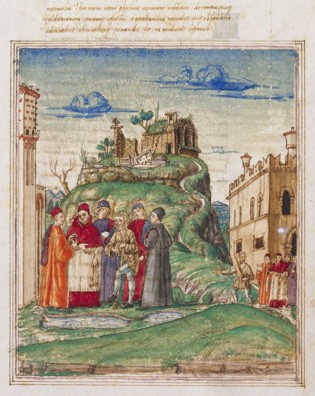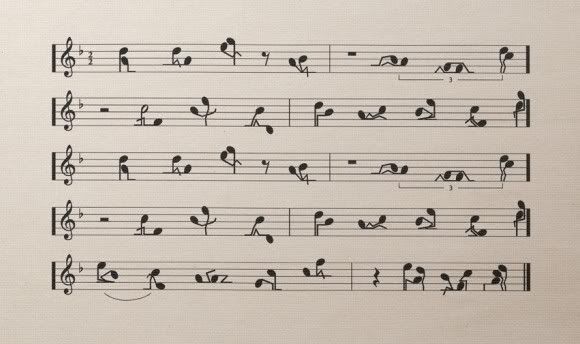Excitement surged loudly through Imperial College’s Great Hall as the announcer belatedly bellowed those four terrifying words, signifying what for one side would be the beginning of the end: “Sssseconds out, Rrrrround One!”
Danny grabbed Charles Hope’s arm: “Am I going to be able to do this?”, he asked. “Do you really think I’ve learnt enough to last five rounds… against him?”
“Relax“, said the Professor languidly as he stepped out through the ropes, “Iconologists are a pushover – they’re all talk. Your informed historical cynicism should win every time.”
“That ‘should‘ word again”, thought Danny with more than a flicker of fear. “Why couldn’t he use something stronger, at a time when I really need moral certainty?”
He rose slowly, trying not to look intimidated by the leviathan bulging menacingly out of the far corner. Sure, Raza Reema was ‘only’ a student iconologist at the Courtauld Institute – but, let’s face it, the guy had an extra stone, two inches of reach and a whole extra post-doc year on Danny. Raza’s second, the formidable Joscelyn Godwin, flicked Danny a hostile glance as he eased himself out of the ring – yes, this was going to be every bit as tough as the TLS preview had predicted.
Yet for over three years, Danny had trained hard for this by grinding his way along each open shelf of the Warburg Institute, exhaustively dredging every book and photo for scraps that might prove decisive tonight – ironically using Aby Warburg’s creation to try to defeat its own research programme. With Hope as his mentor, wimpy post-grad Danny had bloomed into a research golem, equal parts fighting machine and rabbinical debating monster. Under the glare of the Channel 4 cameras, with the funding of the two institutions balancing precariously on the outcome, now was no time to be entertaining doubts.
Rather, it was time to fight – to kill or be killed.
And so the two boxers lurched defiantly towards the centre of the ring, the bell and the crowd’s roar ringing in their ears.
“Iconology is a joke“, snapped Danny as he jabbed quickly at Raza’s ribs, “and you know what? The joke’s on you.”
“Cynicism is a losing path“, retorted Raza flashing shots close to Danny’s face, “that’s more about supposed intellectual safety than bravery. And lamers such as you are neither safe nor brave.”
Danny snapped his head back as a fast cross punch came close to his nose. For an instant, he paused: he thought he could smell something strange and pungent – Paco Rabanne? Juicy Fruit? Myrrh? No time to wonder, as he launched himself back to the fray.
“Speculation without evidence is wasted research funding“, Danny barked grimly through his gumshield, circling lightly around the ring, “and you’ve wasted your life on a dream.”
“Absence of evidence isn’t evidence of absence,” pingponged Raza, feinting to the left. “But funnily enough, you and your crew are pretty short of persuasive evidence too.” Uncoiling quickly, he unwound a powerful right hook that skidded off Danny’s ear.
“For someone so convinced by their thesis, you’re taking a notably nihilistic position“, sneered Danny, tucking himself down inside Raza’s defences to snatch a fast body blow, rocking him on his heels. He smiled to himself as he glimpsed Professor Hope in the corner nodding in obvious appreciation. “Are we really debating in an evidential vacuum?”
Raza pulled back, slowing the tempo right down. “You know there’s evidence”, he sneered, “it’s more a matter of what evidence you choose to believe. Authoritas, eh?”
The bell sounded and the two fighters decamped to their respective corners. “You need to start landing more body blows on the guy“, urged Professor Hope, rubbing Danny’s shoulders briskly with a Mnemosyne-emblemmed towel. “He’s got the reach, but you’ve got the research focus – time to take the fight right to him.” Danny narrowed his sweat-filled eyes across the ring: though Professor Godwin was fingering his bow-tie agitatedly, Raza seemed unmoved, as grimly powerful as ever.
“Rrrrround Two!” shrieked the announcer, the two professors vacated their corners, and the contest started once more.
“Splendor Solis“, Danny called out as he surged forward with a string of jabs towards his opponent’s chest, “is merely eye candy for the soul, feel-good alchemy for the rich: a Renaissance God’s way of telling you you have too much money and too little sense.”
Raza stumbled, taken aback by the force of Danny’s full-frontal attack on his 2007 paper. His mind darted through his extensive bibliography reaching for an obvious refutation, but it all came far too late as Danny ploughed in with a tight one-two to Raza’s solar plexus and chin, sending the Courtauld man backwards onto the canvas and up again for a standing count.
Out of the corner of his eye, Danny could Professor Hope gesticulating to him with his hands, as though he were kneading some kind of symbolic dough. Dough? Meaning money? But surely it was time to finish Raza off?
Immediately the referee signalled for them to resume, Danny hurled himself forward at his opponent, trying to capitalize on his momentary advantage. “What’s the matter?“, he taunted. “The Rosicrucians got your tongue?”
“Cheap trick, Warburg kiddy“, blocked Raza, quickly clubbing Danny’s leading shoulder – the sheer force from the straight blow sent him reeling backwards to the ropes, the shock wave rattling right through to his knees. All at once, he felt his will to win this contest waver, even though four years’ research funding for the Warburg was at stake on its outcome. Has there ever been a fairer way to allocate resources?
However, a steel-edged glance from Professor Hope was enough to push him back to his full height. He then realized his mentor had just now been signalling him to slow the pace down, and not to get too excited – of course, he should have known that Hope wouldn’t try to communicate symbolically, particularly in an arena like this.
The two fighters now stood just beyond an arms’ length from each other, slowly pedalling around, regrouping their thoughts, angling to finding their key technical points of differences.
“So… do you accept that Cesare Ripa made up his emblems“, Danny jabbed quickly, trying to tuck himself beneath Raza’s long reach, “and hence that Panofsky built his iconological castles on sand?”
“I’m cool with that“, scowled Raza as he dropped back a step, firing off a whistling blow close to Danny’s head, “but are you OK with the idea of Lorenzo de’ Medici being a uber-revivalist, a politicking Platonist insider?”
“Uh huh“, Danny nodded darkly, stepping sideways around Raza, “so… what exactly is the difference between us? Do you accept that your Splendor Solis paper was perhaps an over-positivistic iconological presentation of a medieval conceit?”
“Well…“, Raza pondered, also slowing down in the ring, “three years on, I would take a very much more nuanced view of it. My funding specified that I had to construct an iconological case, but it really wasn’t easy.”
Danny suddenly stopped in his tracks, dropping his guard. “So they set you up for this whole thing?”, he said in disbelief. “They locked down your PhD subject, even seconded Joscelyn Godwin in… just because you had ripped abs and could punch for their money?”
“Basically, yes. And what about you?”, queried Raza, similarly dropping his gloves to his sides. “I heard that in your first year at the Warburg you were ‘pagan this’, ‘Edgar Wind that’. How did they get you to switch sides so comprehensively?”
“Yeah…“, replied Danny, “even though all that stuff ‘felt right’, I just couldn’t construct an historical case to support it, and in the end felt I had to drop it. As always, the truth lies in the cracks between.” By now, the packed crowd was starting to boo at the lack of action, and even the referee was edging over to see what was wrong. “Anyway, what aftershave does Professor Godwin wear?”
“Aftershave?“, said Raza in surprise. “Ummm… Paco Rabanne, I think. Why’s that?”
“Actually, I think I smelt some on your gloves“, said Danny.
“Really? On my gloves?” said Raza, reaching down to sniff them.
It was at that precise moment that Danny’s devastatingly strong uppercut hit Raza square beneath his chin, knocking him clean out cold.
“Job done!“, shouted Danny in triumph, as the referee and Charles Hope held up his arms.
“I told you iconologists are a pushover“, said the Professor sideways.
“Yeah, they’ll believe anything you tell ’em“, said Danny, “Anything at all!”
* * * * *
[PS: all names, places, and institutions in this story are utterly fictitious, even when they’re plainly not.]


